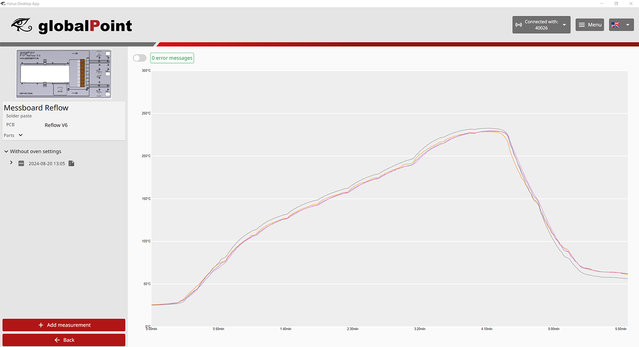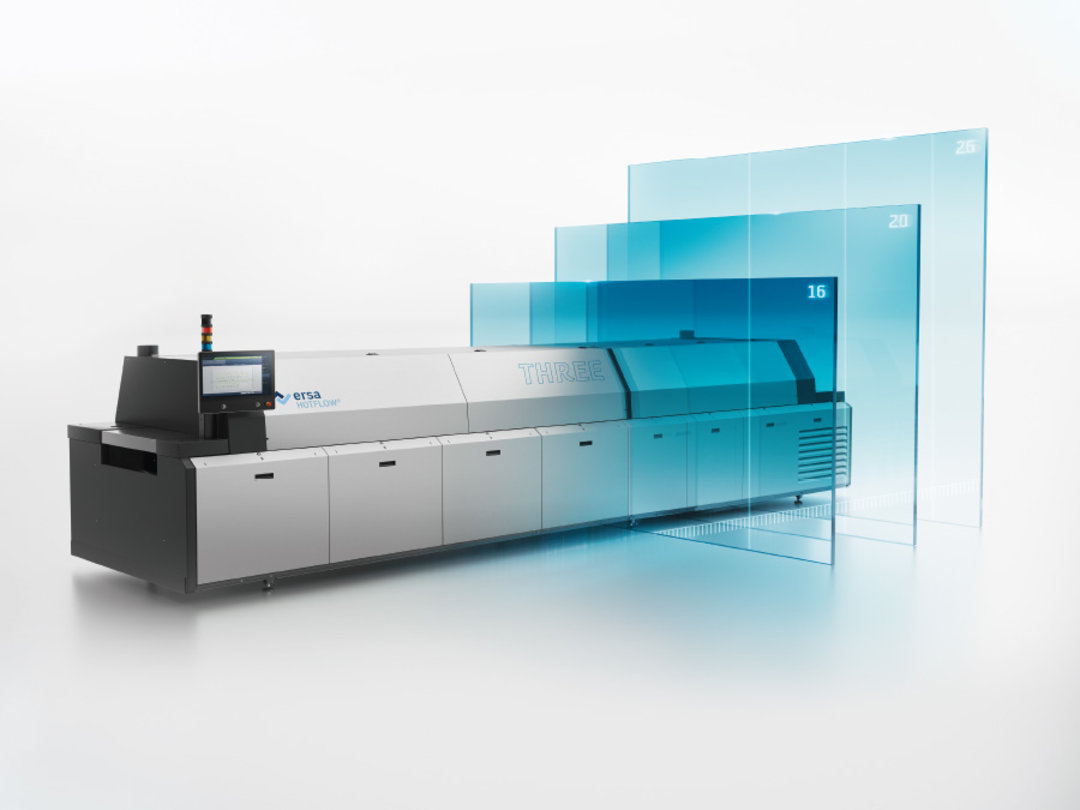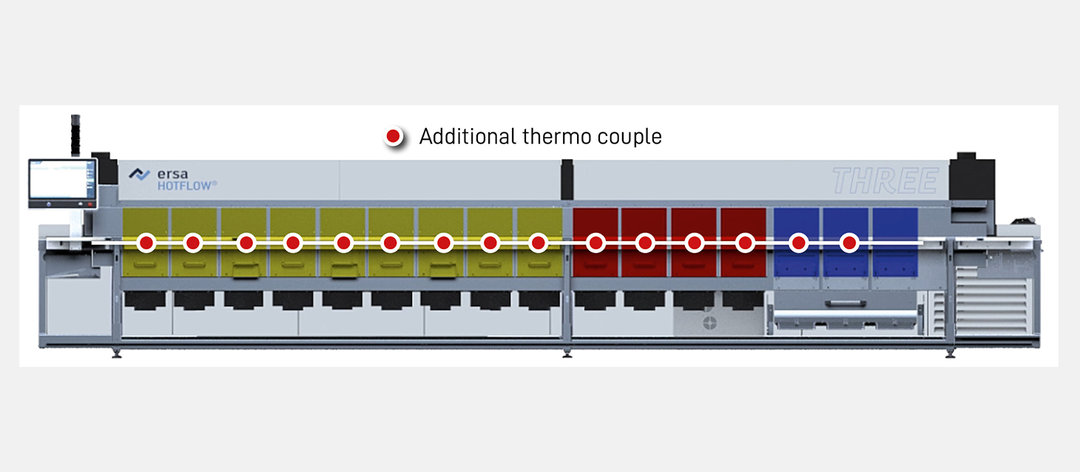Power is nothing without control! Ideal team: HOTFLOW THREE and horus® measuring electronics Technical Report
An ideal team: HOTFLOW THREE and horus® measuring electronics
Reflow ovens are the backbone of modern electronics manufacturing. They are expected to deliver maximum performance, throughput, and availability, but they must also be sustainable. With a modern reflow oven such as the HOTFLOW THREE, a high level of performance can be achieved. Regular process monitoring with a precise measuring system such as horus® is also crucial for success.



Rethinking Reflow Technology - Kurtz Ersa HOTFLOW THREE
The HOTFLOW THREE is the logical evolution of the Ersa HOTFLOW series. Proven technologies have been combined with extensive field experience and feedback. The result is an unmatched user focus and a multitude of clever detail solutions. It goes without saying that the HOTFLOW THREE also sets new standards in terms of performance.
Mastering Major Challenges: Today, the majority of components, in terms of quantity, are assembled using SMT technology. It is not uncommon to have several thousand components per assembly. This is another reason why chip designs in particular are getting smaller and smaller. At the same time, however, the range of components is growing, which means that components that used to be processed using through-hole technology (THT) are now also being processed as SMDs. This requires powerful reflow ovens such as Ersa's HOTFLOW series because only high heat transfer can guarantee low temperature differences across a wide range of components. Keeping this delta low is fundamental to achieving the highest quality, as it is the only way to ensure that high-mass components can be soldered safely while small components do not overheat. Throughput also plays a role because the faster the transport, the greater the temperature delta unless convection is compensated.
Flexible and Efficient Heat Transfer
In the reflow oven, heat transfer to the assembly is largely dependent on convection. Today, it is common that convection can only be set for the entire oven or only for a few areas of the oven. The HOTFLOW THREE introduced the revolutionary concept of the Smart Convection Power Unit (SCPU®). This means that each zone has independent fan heaters at the top and bottom, each of which can be assigned its own values. With the unique degree of freedom in convection settings, it is now possible to control each zone separately, not only ensuring that product specifications are met, but also reducing energy consumption. More targeted convection allows to boost heat transfer precisely where it is needed in the solder profile. This can be at turning points in the profile, for example, where thermal masses lead to different gradients.
Maintaining Process Stability: Even the most stable process needs to be monitored regularly. In reflow, this usually means periodically measuring a defined reference profile with a long-term stable measurement board and measurement equipment. If the values are within the defined tolerance window, the measurement process is archived, and the machine is released for production. Since the measurement is done manually and interferes with regular production, the goal is usually to select the longest possible cycles. This always leaves a small question mark over process reliability. Monitoring systems can solve this problem but are not affordable for all companies. With redundant temperature monitoring at the PCB level, the HOTFLOW THREE offers an inexpensive additional monitoring system that continuously checks the reflow process and energy transfer. The set values are compared with the specified profile, and the oven then monitors the profile independently.
All Performance is Useless Without Control
Precise temperature monitoring and control is a decisive factor in electronics production, especially when setting up soldering profiles. The modern horus® measuring electronics provide extensive features for this purpose, enhancing precision, efficiency, and user-friendliness considerably.
Installation Without Administrator Rights: One of the outstanding features of the horus® measuring electronics is that it can be easily installed without administrator rights. This means that technicians and engineers can set up the device quickly and easily without having to rely on special authorizations. This plug-and-play feature saves time and reduces potential obstacles, which is especially beneficial in large production environments where administrator rights often restrict access.
Windows 11 Ready: Full compatibility with the latest Windows 11 operating system ensures that horus® can be easily integrated into modern IT infrastructures. This support guarantees that the software runs stably and efficiently on the latest computers and laptops, further increasing reliability and usability.
Independent WIFI Access Point and Data Transfer in Real Time: An independent WIFI access point allows the measuring electronics to connect directly and autonomously without the need for additional network infrastructure. The recorded temperature data is reliably sent directly and continuously to the desired receiving device, enabling proactive monitoring and rapid response to possible temperature deviations.
Extra Memory on the Device: Horus® also has an integrated memory. This allows temperature measurements to be recorded even if the measuring electronics are temporarily disconnected from the network. As soon as the connection is re-established, the stored data is automatically transferred. This feature ensures that important data is not lost, and continuous monitoring is guaranteed.
Soldering Profile Simulation Based on Components and Solder Pastes: The ability to simulate soldering profiles based on specific components and solder pastes is an outstanding feature of the horus® measuring electronics. During the development of a new product, this feature enables engineers to determine the optimum soldering conditions and to identify and resolve potential problems early on. This significantly improves product quality and avoids costly rework. Solder profile creation also becomes much more efficient.
Time Savings Thanks to Fast Profile Creation: A good, stable temperature profile is the decisive factor for a successful soldering process. An absolute horus® highlight is the extremely efficient and fast creation of temperature profiles, which is realized through the intuitive software and user-friendly interfaces. This time-saving is particularly valuable in production environments where quick adjustments may be required to optimize production processes and ensure product quality.
Proven Battery Technology and Easy Battery Replacement: To ensure that the measuring electronics can work continuously even during long production runs or extensive test phases, the horus® measuring electronics is equipped with proven rechargeable battery technology that guarantees a long service life and high reliability. The battery rarely needs to be recharged even during intensive use and is also easy to replace, which makes maintenance easier and minimizes downtime.
Indispensable in Modern Electronics Production: All in all, the horus® measuring electronics for temperature monitoring and efficient creation of soldering profiles offer an impressive combination of advanced functions and user-friendliness. Its efficiency increases the quality of the products produced and assists engineers and technicians in creating optimal soldering conditions. These comprehensive features make horus® a valuable investment for companies in the electronics industry.
HOTFLOW THREE
Best reflow performance in every respect - thanks to the three-stage Ersa SMART CLEANING system consisting of the SMART ELEMENTS® filter system, SMART PYROLYSIS CLEANER in the peak zone and the SMART CONDENSATION UNIT in the cooling zone



